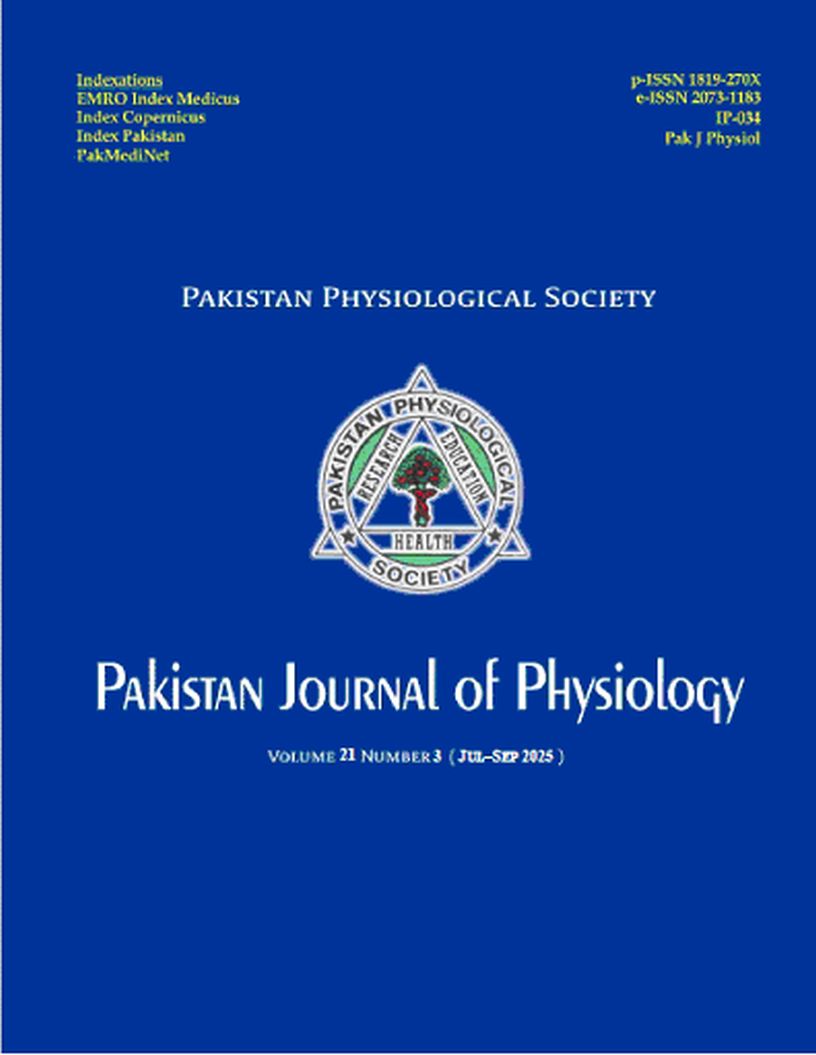EFFECT OF TAURINE AND BETA-ALANINE ON BLOOD GLUCOSE, SERUM INSULIN, AND INSULIN RESISTANCE IN TYPE 2 DIABETIC RATS
DOI:
https://doi.org/10.69656/pjp.v21i3.1786Keywords:
Beta-alanine, Diabetes mellitus, High-fat diet, Insulin resistance, TaurineAbstract
Background: Taurine and beta-alanine have similar structures and compete for the same transporter. The ability to retain taurine and carnosine is impaired in type 2 diabetes mellitus (T2DM). This study was carried out to compare the effect of taurine and beta-alanine on blood sugar, serum insulin, and insulin resistance, in T2DM rats. Methods: This laboratory-based experimental study was conducted from Jul to Sep 2020. Ninety male Sprague Dawley rats were randomly divided into three groups, each comprising of 30 rats. All rats were fed on a taurine-free high-fat diet for 4 weeks. Rats were supplemented in drinking water, as follows: Diabetic control rats with 0.02% (w/v) taurine, diabetic beta-alanine rats with 3% (w/v) beta-alanine, and diabetic taurine rats with 3% (w/v) taurine. On the 14th day, a single intraperitoneal injection of low dose streptozotocin (STZ) (35 mg/Kg), was administered to all rats. On the 21st day, tail vein sampling was done to confirm the development of T2DM. On the 28th day, rats were terminally anaesthetized and intra-cardiac blood samples were used to estimate the blood sugar, serum insulin, and HOMA-IR. Results: Significant differences were found between the control and taurine groups, as well as the beta-alanine and taurine groups. No significant differences were found in these parameters when control group was compared to beta-alanine group. Conclusion: Taurine significantly improves glucose homeostasis in diabetic rats. Future studies should explore taurine in combination with insulin to assess potential dose-sparing effects.
Pak J Physiol 2025;21(3):50–3, DOI: https://doi.org/10.69656/pjp.v21i3.1786
Downloads
References
Zhao D, Yin D, Wang X, Li Y, He M, Hu J, et al. Taurine alleviates high-fat-high-glucose-induced pancreatic islet ?-cell oxidative stress and apoptosis in rat. Heliyon 2023;9(12):e21879.
Cripps MJ, Hanna K, Lavilla CJr, Sayers SR, Caton PW, Sims C, et al. Carnosine scavenging of glucolipotoxic free radicals enhances insulin secretion and glucose uptake. Sci Rep 2017;7(1):13313.
Uchida K. Redox-derived damage-associated molecular patterns: Ligand function of lipid peroxidation adducts. Redox Biol 2013;1(1):94–6.
Vistoli G, De Maddis D, Cipak A, Zarkovic N, Carini M, Aldini G. Advanced glycoxidation and lipoxidation end products (AGEs and ALEs): an overview of their mechanisms of formation. Free Radic Res 2013;47(Suppl 1):3–27.
Mathews JJ, Turner MD, Santos L, Elliot-Sale KJ, Sale C. Carnosine increases insulin stimulated glucose uptake and reduces methylglyoxal-modifed proteins in type 2 diabetic human skeletal muscle cells. Amino Acids 2023;55(3):413–20.
Billacura MP, Lavilla C Jr, Cripps MJ, Hanna K, Sale C, Turner MD. ?-alanine scavenging of free radicals protects mitochondrial function and enhances both insulin secretion and glucose uptake in cells under metabolic stress. Adv Redox Res 2022;6:100050.
Díaz-Rizzolo DA, Serra A, Colungo C, Sala-Vila A, Siso-Almirall A, Gomkis R. Type 2 diabetes preventive effects with a 12-months sardine-enriched diet in elderly population with prediabetes: An interventional, randomized and controlled trial. Clin Nutr 2021;40(5):2587–98.
Moludi J, Qaisar SA. Khadim MM, Ahmadi Y, Davari M. Protective and therapeutic effectiveness of taurine supplementation plus low calorie diet on metabolic parameters and endothelial markers in patients with diabetes mellitus: a randomized, clinical trial. Nutr Metab (Lond) 2023;19(1):49.
Ito T, Schaffer SW, Azuma J. The potential usefulness of taurine on diabetes mellitus and its complications. Amino Acids 2012;42(5):1529–39.
Everaert I, He J, Hanssens M, Stautemas J, Bakker K, Albrecht T, et al. Carnosinase-1 overexpression, but not aerobic exercise training, affects the development of diabetic nephropathy in BTBR ob/ob mice. Am J Physiol Renal Physiol 2020;318(4):F1030–40.
Maleki V, Mahdavi R, Hajizadeh-Sharafabad F, Alizadeh M. The effects of taurine supplementation on oxidative stress indices and inflammation biomarkers in patients with type 2 diabetes: a randomized, double-blind, placebo-controlled trial. Diabetol Metab Syndr 2020;12:9.
Yassin MM, Mwafy SN. Protective potential of glimepiride and nerium oleander extract on lipid profile, body growth rate, and renal function in streptozotocin-induced diabetic rats. Turk J Biol 2007;31:95–102.
Rasul A, Latif N, Batool A, Ali S, Arshad S, Siddique L. Effect of taurine on biomarker of oxidative stress in serum of high fat diet-low dose streptozotocin injected model of type 2 diabetic rats. Pak J Physiol 2022;18(3):11–4.
Rasul A, Latif N, Ali S, Ashfaq M, Mubarak S, Rehman I. Taurine supplementation normalizes skeletal muscle functions in type 2 diabetic rats. Pak Armed Forces Med J 2020;70(1):224–9.
Srinivasin K, Viswanad B, Asrat L, Kaul CL, Ramarao P. Combination of high-fat diet-fed and low-dose streptozotocin-treated rat: A model for type 2 diabetes and pharmacological screening K. Pharmacol Res 2005;52(4):313–20.
Murakami S, Funahashi K, Tamagawa N, Ning M, Ito T. Taurine ameliorates streptozotocin-induced diabetes by modulating hepatic glucose metabolism and oxidative stress in mice. Metabolites 2022;12(6):524.
Albrecht T, Schilperoort M, Zhang S, Braun JD, Qiu J, Rodriguez A, et al. Carnosine attenuates the development of both type 2 diabetes and diabetic nephropathy in BTBR ob/ob mice. Sci Rep 2017;7:44492.
Hudkins KL, Pichaiwong W, Wietecha T, Kowalewska J, Banas MC, Spencer MW, et al. BTBR Ob/Ob mutant mice model progressive diabetic nephropathy. J Am Soc Nephrol 2010;21(9):1533–42.
Karkabounas S, Papadopoulos N, Anastasiadou C, Gubili C, Peschos D, Daskalou T, et al. Effects of ?-lipoic acid, carnosine, and thiamine supplementation in obese patients with type 2 diabetes mellitus: a randomized, double-blind study. J Med Food 2018;21(12):1197–203.
Downloads
Published
How to Cite
Issue
Section
License
Copyright (c) 2025 Amina Rasul, Arsal Sami, Ghazala Jawwad, Nadia Latif, Irum Rehman, Jaleel Kamran

This work is licensed under a Creative Commons Attribution-NoDerivatives 4.0 International License.
The author(s) retain the copyrights and allow their publication in Pakistan Journal of Physiology, Pak J Physiol, PJP to be FREE for research and academic purposes. It can be downloaded and stored, printed, presented, projected, cited and quoted with full reference of, and acknowledgement to the author(s) and the PJP. The contents are published with an international CC-BY-ND-4.0 License.











